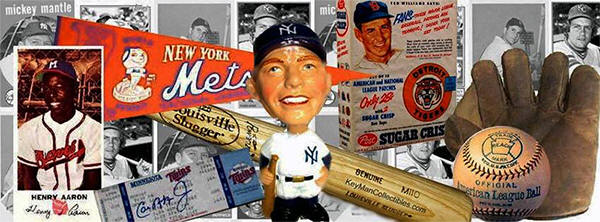|
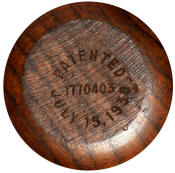 |
|
1930 Patent Information Added To Knob |
|
 |
| 1931 Catalog |
|
 |
1931 Barrel Stamping
Players Last Name |
|
 |
1934-1935 Barrel Stamping
Player "Type" |
|
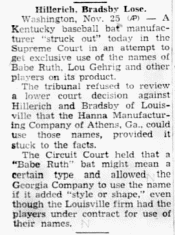 |
| 1935 Court Dession |
|
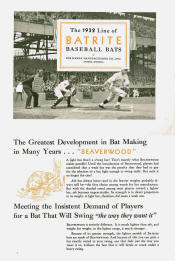 |
| 1932 Catalog |
|
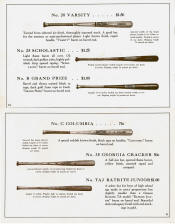 |
| 1933 Catalog |
|
 |
| 1936 Catalog |
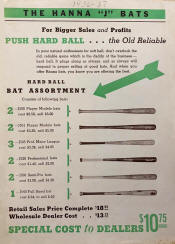 |
| 1936 Catalog |
|
|
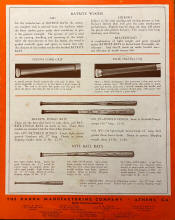 |
| 1937 Catalog |
|
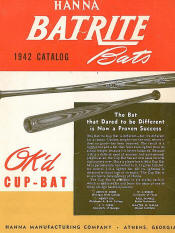 |
| 1942 Catalog |
|
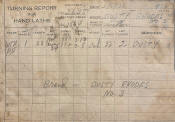 |
| Turning Report For Hand Lathe
Custom Made Bats |
|
|
|
|
|
| |
Burke-Hanna MFG Company Baseball Bats |
|
| |
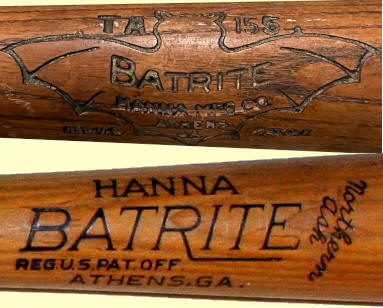 |
|
Hanna MFG Company
Batrite Baseball Bats |
|
|
Item Details |
|
MANUFACTURING PERIOD
1925-1976
MANUFACTURER
Hanna Manufacturing
Company
Athens, Georga
Information
Provided by:
Keymancollectibles.com

|
|
|
|
| |
|
|
| |
The Hanna Manufacturing Company of Athens, Georgia, was
established in 1911 by Clay Hanna. The
company turned
out handles for scoops, shovels,
and spades in Macon, GA, then moved to
Athens Georgia in 1921. William Burke,
founded the Burke Golf Company in 1910.
After losing
control of the company to Robert
Crandall in 1922, Burke left the firm
in 1925, and formed a partnership with
Clay Hanna, and Robert Crandall's brother L.W. Crandall, who was
vice president of the Hanna
Manufacturing Company.
In 1925 Hanna expanded into making toy
bats for discount and department stores
which
featured the Burke-Hanna MFG. C., "Flying Bat" trademark
logo. By 1927 Hanna
started the production of baseball bats for
sporting goods stores, colleges, and
Major League ballplayers.
The "Flying Bat" Logo is the earliest
used by Hanna and dates to about 1925
to 1935. "Reg. U.S. Pat. Off." was added below the
Flying Bat Logo around
1927. In April 1932, the Hanna Manufacturing Company applied for a patent for a
new center brand for its bats in the
shape of an oval. Hillerich & Bradsby
filed for an injunction against the
copyright and patent, but the
"Burke-Hanna" oval center brand
baseball bats were produced and hit the
market in 1933.
After the injunction was filed by Hillerich & Bradsby,
Hanna brought the "Flying Bat"
logo out of retirement, until they came
up with a new design for 1936.
In 1934 Hillerich & Bradsby was granted an injunction to restrain
Hanna from using on its baseball bats
the names of noted players whom H&B
have under contracts.
Hanna had to produce a new flying Bat logo dye for 1934-1935, and the name Burke
was left out. The Barrel branding was
redesigned and the word "Type" was
added after the players last name. The
1931 and 1932 catalogs have the TA and
model number on the barrel with the
players last name.
Bats made after the injunction have
the TA and model number atop the Bat
logo.
The 1932 case against Hanna was withdrawn due to the Court not having jurisdiction. The Hillerich & Bradsby Co. refiled the case on January 12,
1933 and included in their summery that
by using an oval/ellipse, and also
adding the name of a player on the end
of the bat, Hanna was violating the
Hillerich & Bradsby Co.
oval trademark by making Hanna bats
look like Louisville Sluggers. Hanna counter sued
saying that H&B had stolen their
process of hardening their bats with a
glue.
The patent for a method for treating baseball bats, golf clubs, etc, was
filed on October 17, 1928 by Henry Clay
Hanna.
Patent no. 1,770,403, is granted on
July 15, 1930, and this information is
added to the knob.
The new "Hanna Batrite" branding introduced in 1936, was used until
1976 when the company closed. In 1962 "Northern Ash"
was added to the right of
the "Hanna Batrite" center brand.
In 1937 "Burke-Hanna
Quality Baseball bats" featured a
"Hanna MFG Company, Burke-Hanna, Athens
Georgia" center brand. Hanna's
Flagship line of Batrite models used the trademark
branding introduce in 1936.
|
|
| |
|
Burke-Hanna MFG Company
Baseball Bat Dating
Guide |
|
The Hanna Manufacturing Company
used a number of center brands
over the years. The Logo
samples pictured below are listed in chronological order,
dated to the years they appear
in catalogs. |
|
 |
 |
|
1925-1926 |
1927-1929 |
|
|
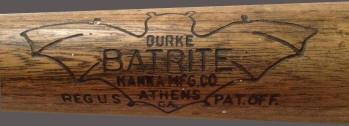 |
 |
| 1930-1932 |
1933 |
|
|
 |
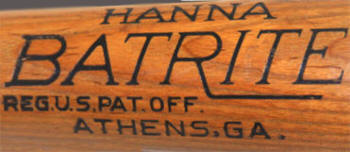 |
| 1934-1935 |
1936-1976 |
|
|
|
Inexpensive Store Models |
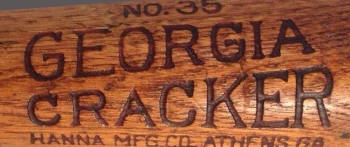 |
 |
| 1933-1949 |
1933-1934? (Columbia) |
|
|
 |
|
1937 |
|
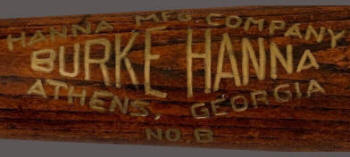 |
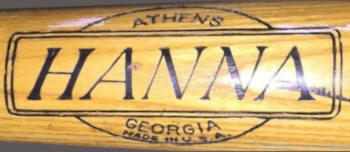 |
| 1937-1942 |
1949-1976 |
|
|
|
KEYMAN COLLECTIBLES
RELATED RESOURCES |
|
|
|
| |
|
|
| |
 |
|
| |
|
|
| |
|
|
| |
|
|
| |
 |
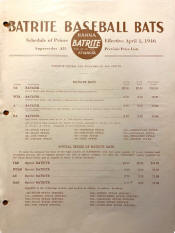 |
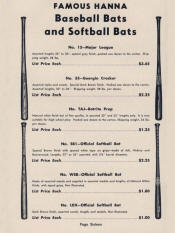 |
 |
| 1942 Catalog |
1946 Catalog |
1949 Catalog |
1951 Catalog |
|
|
| |
|
|
| |
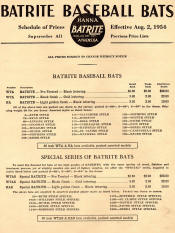 |
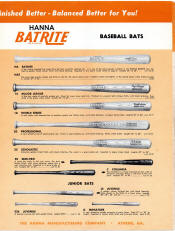 |
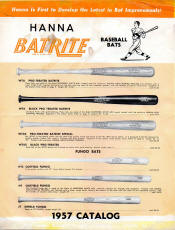 |
 |
| 1954 Catalog |
1955 Catalog |
1957 Catalog |
1961 Catalog |
|
|
| |
|
|
| |
 |
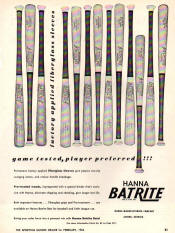 |
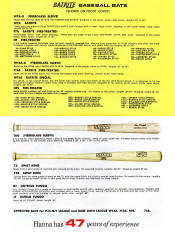 |
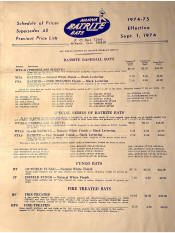 |
| 1962 Catalog |
1964 Ad |
1973 Catalog |
1974-75 Catalog |
|
|
| |
|
|
| |
Hanna Manufacturing Co. Baseball Bat Features |
|
| |
|
|
| |
 |
|
| |
|
|
|
| |
In 1930 Hanna's patented non-chipping
treatment was granted. The method of treating a
baseball bat impregnating the outer layers of the bat
barrels with a mixture containing casein glue, while
preserving the handle portion and core of the bat in
its natural condition. Hanna's 1932 countersuit that
Hillerich & Bradsby had stolen their process of
hardening their bats with the same glue, (Powerized) was dismissed
by the court, stating that "Both parties are free to
practice it." The court ruled the Hanna method
patents invalid.
In 1935, the Flox "hold fast" grip was introduced and a cork grip was
marketed in 1936. Hanna also introduced the CM - Custom
Made - Bats with Registered Balance. Each CM-Custom
Made bat is registered at the factory, enabling the bat
to be reordered using the unique serial number to
duplicate the exact specifications; style, length,
weight, wood, finish and balance.
In 1972, "The cupped-end bat" was approved by the major leagues. It was
thought to be a Japanese innovation at the time but,
the Hanna Batrite company, introduced the cup-Bat in
the 1930s. "The bat with the concaved end" was in fact
patented and manufactured in 1898 by the Robert Reach
Manufacturing Co. of Philadelphia.
Around 1962 Hanna marketed the fiberglass sleeve, which was incorporated
into the bat handle. The purpose of this sleeve was to
reduce the number of broken bats. Believed to be a
Hanna MFG Co. innovation the patent was actually
applied for by the
Mueller Perry Co. in 1960. The Patent was approved
in 1964, but the company began to market the product in
1961. |
|
|
|

